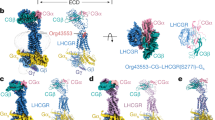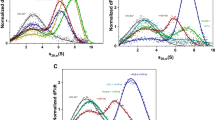Abstract
Earlier reports of oestrogen receptor binding to DNA1–4 indicated that a protein which does not bind oestrogen might be involved in the conversion of the 4S oestradiol receptor to the 5S form but no direct evidence for the existence of this protein was presented. This receptor transformation or activation step is thought to be a requirement for events in the nucleus. We considered it likely that such a protein might be similar to the cytoplasmic proteins which stimulate eukaryotic RNA poly-merases5–11. These are basic proteins which are not adsorbed to DEAE cellulose and have a sedimentation coefficient of ∼3S. To examine this possibility, we fractionated unlabelled uterine cytosol by DEAE-cellulose chromatography. Unlabelled cytosol was used to avoid the possibility that such a factor might be retained on the column as a component of the receptor-oestradiol complex. Here we present evidence of a protein present in uterine cytosol which forms a complex with the 4S form of the oestrogen receptor to produce a SS-activated form. This activated form binds to uterine nuclei, DNA-cellulose and native calf thymus DNA. The cytosol protein, which we call receptor activation factor, does not bind oestradiol, has a sedimentation coefficient of ∼3S and does not bind to DEAE-cellulose.
This is a preview of subscription content, access via your institution
Access options
Subscribe to this journal
Receive 51 print issues and online access
$199.00 per year
only $3.90 per issue
Buy this article
- Purchase on Springer Link
- Instant access to full article PDF
Prices may be subject to local taxes which are calculated during checkout
Similar content being viewed by others
References
Yamamoto, K. R. J. biol. Chem. 249, 7068–7075 (1974).
Notides, A. C. & Neilson, S. J. biol. Chem. 249, 1866–1873 (1974).
Yamamoto, K. R. & Alberts, B. M. Cell 4, 301–310 (1975).
Thrower, S., Hall, C., Lim, L. & Davison, A. N. Biochem. J. 160, 270–280 (1976).
Seifart, K. H. Cold Spring Harb. Symp. quant. Biol. 35, 719–725 (1970).
Stein, H. & Hausen, P. Cold Spring Harb. Symp. quant. Biol. 35, 709–717 (1970).
Natori, S. J. Biochem. 72, 1291–1294 (1972).
Lentfer, D. & Lezius, G. Eur. J. Biochem. 30, 278–284 (1972).
Natori, S., Takeuchi, K., Takahashi, K. & Mizuno, D. J. Biochem. 73, 879–888 (1973).
Lee, S. C. & Dahmus, M. E. Proc. natn. Acad. Sci. U.S.A. 70, 1383–1387 (1973).
Seifart, K. H., Juhasz, P. P. & Benecke, B. J. Eur. J. Biochem. 33, 181–191 (1973).
Clark, J. H. & Peck, E. J. Jr Female Sex Steroids: Receptors and Function 4–36 (Springer, Berlin, 1979).
Alberts, B. M. & Herrick, G. Meth. Enzym. 21, 198–217 (1971).
Bresciani, F., Puca, G. A., Nola, E. & Sica, V. in Control of Proliferation of Animal Cells (eds Clarkson, B. & Baserga, R.) 67–83 (Cold Spring Harbor Laboratory, New York, 1974).
Lowry, O. H., Rosebrough, M. J., Farr, A. L. & Randall, R. J. J. biol. Chem. 193, 265–275 (1951).
Burton, K. Biochem. J. 62, 315–323 (1956).
Author information
Authors and Affiliations
Rights and permissions
About this article
Cite this article
Thampan, T., Clark, J. An oestrogen receptor activator protein in rat uterine cytosol. Nature 290, 152–154 (1981). https://doi.org/10.1038/290152a0
Received:
Accepted:
Issue Date:
DOI: https://doi.org/10.1038/290152a0
Comments
By submitting a comment you agree to abide by our Terms and Community Guidelines. If you find something abusive or that does not comply with our terms or guidelines please flag it as inappropriate.



